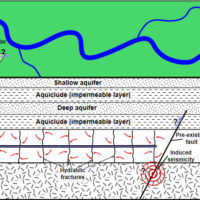Revisiting the Chesapeake Bay
The Effect of Population Growth on America’s Largest Estuary
- Tom Horton
- March 28, 2013
- Forum Papers
- Forum Paper
- 0 Comments
These are the facts, 30 years after the Chesapeake’s restoration began, according to Horton: at least short- term improvement is possible if we strengthen political will, enforce the environmental laws that achieved major air and water improvements in the 1970s, increase funding by several billion dollars, and reform weak zoning that permits rampant development of the Bay’s sensitive shorelines and rural lands.
Even so, a blind spot remains large enough to keep us from ever recapturing the glory days of the Chesapeake environment – water quality and habitat for fish and wildlife similar to that of the 1950s, the goal of the restoration.
The blind spot is the American allegiance – some would say addiction – to perpetual economic growth, and to encouraging an ever-expanding population of human consumers to support it. This is the American, pro-growth-economy mantra we are up against:
Growth is good, or necessary to our economy, or at least inevitable and must be “accommodated.”
So accepted and unchallenged is this premise that day to day, we discuss it little more than we do the gravitational force that holds us to the planet. But this misinformed attitude unfortunately leads to a far worse philosophy:
America seems to blindly insist that with better plans, management, and technology, the human population and economy can grow indefinitely while assuring a sustainable and high level of environmental quality, including room for the rest of nature. We vow to return today’s Bay, inhabited by 17 million people, back to the 1950s – when 8 million people lived along the watershed. We presume we can, in other words, reduce our current environmental impact by half. And reduce it enough extra to totally offset all the new impacts on air, water, and land from the 1.7 million more projected to move to the Bay watershed every decade.
That is what we continue to assume, with the connivance of most elected, environmental and science leaders, even after 30 years of failing to do it: Growth is good, Growth is necessary, Growth will come, Growth can be accommodated. these are the greatest, most uncritically accepted, and fatally flawed assumptions made by those charged with protecting the natural resources of the Chesapeake Bay and our nation as a whole.
By an end to growth we do not mean an end to capitalism, stock markets, free trade, innovation, the profit motive, or even to greed and corruption.
Economic development would continue to underpin our prosperity – a shift to building more comfortable, affordable, and energy-efficient homes versus more homes; to producing tastier, more nutritious burgers with less impact on the environment, rather than more and bigger ones; to rebuilding our cities and towns and mass transit systems versus expanding roads and the suburbs. This focus on a “steady state” economy, rather than on a high-growth one, will better serve those already here, instead of making endless and expensive accommodations for all who might be induced to come.
And while the Chesapeake and its water quality are the focus of my research, the implications extend to the nation as a whole; and across a range of growth- related factors determining our quality of life, from traffic congestion and loss of open spaces, to the more regulated existence that ensues when accommodating more people in a finite space.
We already know what we need to do. For decades, government and environmental leaders in the Bay region have acknowledged that growth without limits is at odds with a sustainable environment. Unfortunately, elected leaders and environmental groups have chosen to ignore (some even deny) this fact on a national scale – making it all the more important for citizens across America to recognize the warning signs from our struggling Bay and voice their concerns now, before it is too late.
At the first modern Maryland-Virginia conference on Bay health in 1977, the concluding speaker, marine scientist J. L. McHugh, summarized the meeting:
One theme has run like a thread through this conference… an issue that is almost always evaded and certainly never addressed seriously… the human population explosion. If we cannot cope with it, maybe everything else will be in vain.
Ten years later, the 1987 update of the Chesapeake Bay Restoration Agreement, signed by Maryland, Virginia, Pennsylvania, and the EPA, stated: “[There is] a clear correlation between population growth and associated development and environmental degradation in the Chesapeake Bay system.”
A year later, the 1988 “Population Growth and Development in the Chesapeake Bay Watershed to the Year 2020” report (by Maryland, Virginia, and Pennsylvania) accurately predicted: “Today, unmanaged new growth has the potential to erase any progress made in Bay improvements…”
Tom Horton covered environmental issues for The Baltimore Sun from 1974 – 2006 and was an educator at the Chesapeake Bay Foundation for five years. He is author of several books about Chesapeake Bay and has written for National Geographic, The New York Times and The Boston Globe. He teaches writing and environmental studies at Salisbury University, and contributes regularly to Chesapeake Bay Magazine and the
Bay Journal News Service . He currently lives in Salisbury, MD, where he is a professor of Environmental Studies at Salisbury University and a contributor to the Bay Journal.

